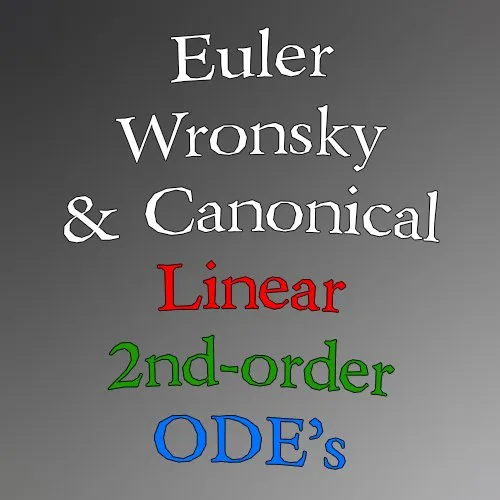
Hello it's a me again drifter1! Today we continue with Mathematics to talk about some special forms of 2nd-order (linear) Differential Equations. To solve the first form (Euler) you have to know the constant coefficient form that we covered last time. The others are methods that are used to solve 2nd-order ODE's in general, when we don't have a specific form (unknown) etc.
So, without further talk, let's get into it!
Quick Recap
An 2nd-order linear ODE is of the form:
y" + P(x)y' + Q(x)y = R(x)
When P(x) and Q(x) don't contain x and are real numbers then we get:
ay" + by' + cy = R(x)
which is the constant coefficient form.
Linear Euler ODE's [ax^2y" + bxy' + cy = R(x)]
An Euler ODE looks similar to an 2nd-order polynomial equation ax^2 + bx + c.
That's an easy way of distinguishing it!
We have ax^2, bx and c be coefficients of y", y' and y.
When an ODE is of that form we do the following:
x = e^t => t = lnx
Doing that we get a new ODE of the form:
ayt" + (b-a)yt' + cyt = R1(t) (can be proven)
This new ODE is of course of the constant coefficient form with t instead of x.
After finding yt we find the solution y using:
y = yt(lnx)
For example:
3x^2y" -7xy' + 9y = 5x^2 [Euler ODE]
3yt" + (-7-3)yt' + 9yt = R1(t) =>
3yt" -10yt' + 9yt = 5*e^2t [Constant coefficient linear ODE]
Linear Wronsky ODE's
A Wronsky ODE is not actually a type/form, but a "condition"!
The solutions y1, y2 of the ODE must be linear independent.
This can be found out by checking:
W(y1, y2) != 0 =>
| y1 y2|
|y1' y2'| != 0
W(y1, y2) is the Wronsky determinant of y1 and y2.
This is useful cause when y1, y2 are linear independent then:
W' = -PW => W = e^[-integral(P(x)dx)]
And so knowing one of the solutions can give us the other one:
y1: known solution => y2 = y1*integral[W/y1^2]dx
So, in cases where we know one of the solutions already we can find out the other one by finding the Wronsky determinant W and then the other solution using the final equation with the integral.
When having an unknown form, we might find one solution (maybe even given) easily. That way using this method we can find the second one and so calculate y0 (solution of the homogeneous) directly! The other part (yp) can then be found using the R(x) cases we discussed last time (or the Lagrange method if of unknown form), and after that the general solution is a piece of cake! (y = y0 + yp)
Canonical Linear ODE's
The Lagrange method is useful when:
- The ODE is of an unknown form (not a known type)
- or we want to calculate the solution yp knowing y1, y2 already (R(x) will be of an unknown form)
This method is based on the canonical form:
Y" + AY = 0
where:
- y = g*Y, where g(x) = e^[-1/2*integral(P(x)dx)] = root(W)
- A = -1/2*P' - 1/4*P^2 + Q
(this can be proven)
The canonical form is an even simpler case then the constant coefficient form!
So, we find the solution Y (constant coefficient form), calculate g(x) and get the general solution from:
y = g*Y
For example:
y" + 2x^3y' + (x^6 + 3x^2 - 1)y = 0 [given ODE]
A = -1/2*P' - 1/4*P^2 + Q =>
A = -1/2*6x^2-1/4*4x^6 + (x^6 + 3x^2 - 1) => ... =>
A = -1
That way:
Y" + AY = 0 =>
Y" - Y = 0 [canonical form of given ODE]
Finding the solutions Y1, Y2 and so Y, and also g(x) we can then find y = gY.
Having g(x) be a solution of the homogeneous, we can substitute Y' = u to get an 1st-order linear ODE.
The solution yp of the given ODE will then be:
yp = y2*integral[R(x)y1/W]dx - y1*integral[R(x)y2/W]dx,
where y1, y2 are the solutions of the corresponding homogeneous.
This last equation is useful when we found the 2 solutions y1 and y2 of the corresponding homogeneous and want to find a solution yp, but have an unknown-form R(x) function!
For example:
R(x) = e^x / x^2 [unknown form]
To solve a 2nd-order ODE that contains this, we off course can't use the cases from last time, but need to find the solutions y1, y2 of the homogeneous and then use the last equation!
Previous posts of the series:
Introduction -> Definition and Applications
First-order part(1) -> Separable, homogeneous and exact 1st-order ODE's
First-order part(2) -> Linear, Bernoulli and Riccati first-order ODE's
First-order exercises -> Exercises for all the 1st-order ODE types
Second-order linear with const coeffs -> Constant coefficient linear 2nd-order ODE's
And this is actually it and I hope that you enjoyed it!
Next time we will get into exercises of 2nd-order ODE's in general!
Bye!
